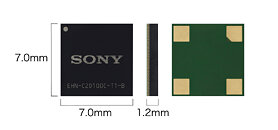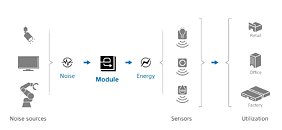T0@st
News Editor
- Joined
- Mar 7, 2023
- Messages
- 2,916 (3.79/day)
- Location
- South East, UK
| System Name | The TPU Typewriter |
|---|---|
| Processor | AMD Ryzen 5 5600 (non-X) |
| Motherboard | GIGABYTE B550M DS3H Micro ATX |
| Cooling | DeepCool AS500 |
| Memory | Kingston Fury Renegade RGB 32 GB (2 x 16 GB) DDR4-3600 CL16 |
| Video Card(s) | PowerColor Radeon RX 7800 XT 16 GB Hellhound OC |
| Storage | Samsung 980 Pro 1 TB M.2-2280 PCIe 4.0 X4 NVME SSD |
| Display(s) | Lenovo Legion Y27q-20 27" QHD IPS monitor |
| Case | GameMax Spark M-ATX (re-badged Jonsbo D30) |
| Audio Device(s) | FiiO K7 Desktop DAC/Amp + Philips Fidelio X3 headphones, or ARTTI T10 Planar IEMs |
| Power Supply | ADATA XPG CORE Reactor 650 W 80+ Gold ATX |
| Mouse | Roccat Kone Pro Air |
| Keyboard | Cooler Master MasterKeys Pro L |
| Software | Windows 10 64-bit Home Edition |
Sony Semiconductor Solutions Corporation (SSS) today announced that it has developed an energy harvesting module that uses electromagnetic wave noise energy. The new module applies technology that SSS has cultivated in the tuner development process to generate power from electromagnetic wave noise with a high level of efficiency. For example, this technology can use the constant electromagnetic wave noise generated by robots inside factories, monitors and lighting in offices, monitors and TVs in stores and homes, and the like to provide the stable power supply needed to run low-power consumption IoT sensors and communications equipment.
With attention on the challenge of providing power to the increasing number of IoT devices as they grow in popularity and sophistication, this highly efficient energy harvesting technology shows promise for a wide range of applications. SSS aims to employ the new technology as part of its effort to build a power circulation model, thereby contributing to the development of a sustainable IoT society.


Energy harvesting is a technology that is expected to contribute to both the development of IoT and the sustainability of the global environment, with research being carried out mainly in fields such as electrical waves, light, heat, and vibration. SSS's new technology is the energy harvesting technology to generate power utilizing the electromagnetic wave noise that all electrical equipment generates.

Usage scenarios—Factory (Left), Office (Middle), Retail (Right)
Based on antenna technology created during tuner development at SSS, this new module uses the metal parts of electronic devices that serve as the source of electromagnetic wave noise as part of an antenna and employs a rectifier circuit with enhanced electricity conversion efficiency, for a highly original structure. This allows it to convert electromagnetic wave noise in a range of several Hz to 100 MHz into electrical energy and supply power to low-power consumption IoT sensors and communications equipment, or to charge batteries, despite its compact size. This is the industry's first energy harvesting technology based on this method that achieves highly efficient power generation. By efficiently utilizing previously ignored electromagnetic wave noise as a new power source, it enables a stable power supply for equipment.
The minimal number of constituent components used in the module yields a compact design that allows for greater freedom of installation. Also, as long as electronic devices are powered, energy can be harvested even while they are not in active use, making this technology promising in a wide variety of usage situations such as factories, offices, stores, and homes, both indoors and outdoors.
Main Features
High level of power generation—Utilizing electronic equipment that generates a significant amount of electromagnetic wave noise such as household appliances, computers, lighting equipment, vending machines, elevators, automobiles, and industrial equipment as an energy source enables this module to harvest from several dozen μW to several dozen mW of power. Doing so makes it possible to supply power to low-power consumption IoT sensors and communications equipment
Applicable to a wide range of use cases
Device status can be identified
Because this technology continuously harvests electromagnetic wave noise from electronic devices, it can also identify the internal status of the electronic device by detecting changes in the harvested voltage. This means, for instance, that it can be used for applications such as detecting whether lighting is functioning normally or predicting device failure, for example in robots with built-in motors.
SSS looks forward to working with partners from various industries to develop products based on this technology, which shows promise across a wide variety of applications.
View at TechPowerUp Main Site | Source
With attention on the challenge of providing power to the increasing number of IoT devices as they grow in popularity and sophistication, this highly efficient energy harvesting technology shows promise for a wide range of applications. SSS aims to employ the new technology as part of its effort to build a power circulation model, thereby contributing to the development of a sustainable IoT society.


Energy harvesting is a technology that is expected to contribute to both the development of IoT and the sustainability of the global environment, with research being carried out mainly in fields such as electrical waves, light, heat, and vibration. SSS's new technology is the energy harvesting technology to generate power utilizing the electromagnetic wave noise that all electrical equipment generates.

Usage scenarios—Factory (Left), Office (Middle), Retail (Right)
Based on antenna technology created during tuner development at SSS, this new module uses the metal parts of electronic devices that serve as the source of electromagnetic wave noise as part of an antenna and employs a rectifier circuit with enhanced electricity conversion efficiency, for a highly original structure. This allows it to convert electromagnetic wave noise in a range of several Hz to 100 MHz into electrical energy and supply power to low-power consumption IoT sensors and communications equipment, or to charge batteries, despite its compact size. This is the industry's first energy harvesting technology based on this method that achieves highly efficient power generation. By efficiently utilizing previously ignored electromagnetic wave noise as a new power source, it enables a stable power supply for equipment.
The minimal number of constituent components used in the module yields a compact design that allows for greater freedom of installation. Also, as long as electronic devices are powered, energy can be harvested even while they are not in active use, making this technology promising in a wide variety of usage situations such as factories, offices, stores, and homes, both indoors and outdoors.
Main Features
High level of power generation—Utilizing electronic equipment that generates a significant amount of electromagnetic wave noise such as household appliances, computers, lighting equipment, vending machines, elevators, automobiles, and industrial equipment as an energy source enables this module to harvest from several dozen μW to several dozen mW of power. Doing so makes it possible to supply power to low-power consumption IoT sensors and communications equipment
Applicable to a wide range of use cases
- As long as electronic devices are powered, power can be harvested even when they are not in active use. This method therefore differs from other energy harvesting methods which use sunlight, electrical waves, and temperature differences, all of which are susceptible to environmental factors such as lighting brightness and indoor environments. Thus, the new module enables continuous harvesting.
- The minimal number of constituent components used in the module yields a compact design that allows for greater freedom of installation.
Device status can be identified
Because this technology continuously harvests electromagnetic wave noise from electronic devices, it can also identify the internal status of the electronic device by detecting changes in the harvested voltage. This means, for instance, that it can be used for applications such as detecting whether lighting is functioning normally or predicting device failure, for example in robots with built-in motors.
SSS looks forward to working with partners from various industries to develop products based on this technology, which shows promise across a wide variety of applications.
View at TechPowerUp Main Site | Source



